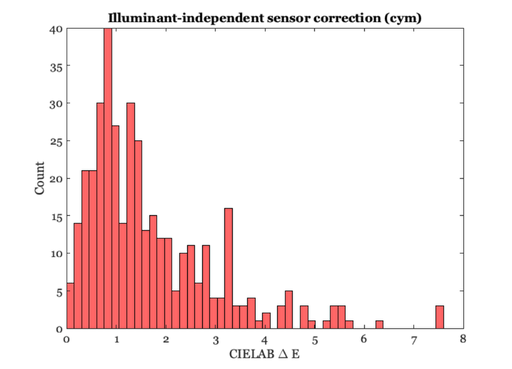Calculate sensor conversion matrices for a surface reflectance chart.
Sensor conversion is a transformation, often implemented by a matrix multiply, that transforms the sensor data into a calibrated color space. An example is the CIE-XYZ space.
In this script we examine the stability of the best transformation matrix under different illuminants.
Several of the analyses are performed using the calibrated Nikon camera sensor spectral responsivities.
Copyright ImagEval Consultants, LLC, 2010
Contents
- Choose scene surface reflectances
- Choose illuminant blackbodies
- Create a Nikon sensor with an infrared cut filter.
- Estimated sensor correction transforms for the different illuminants
- Not correctly implemented
- Plot the corrected and desired for each illuminant case
- Use the average of the linear transformations
- Create a sensor with different filters. (CYM)
- Estimated sensor correction transforms for the different illuminants
- Plot the corrected and desired for each illuminant case
- Use the average of the linear transformations to compute delta E
ieInit;
Choose scene surface reflectances
% Choose reflectance data for testing sFiles = cell(1,2); sFiles{1} = which('MunsellSamples_Vhrel.mat'); sFiles{2} = which('Food_Vhrel.mat'); %{ sFiles{1} = fullfile(isetRootPath,'data','surfaces','reflectances','MunsellSamples_Vhrel.mat'); sFiles{2} = fullfile(isetRootPath,'data','surfaces','reflectances','Food_Vhrel.mat'); %} % Number of samples from each of the files sSamples = [48 16]; % pSize = 16; [scene, samples] = sceneReflectanceChart(sFiles,sSamples,pSize); % sceneWindow(scene);
Choose illuminant blackbodies
bbodyList = (3000:1000:8500);
nIlluminant = length(bbodyList);
% For plotting CIELAB dE graphs on a common scale
maxDE = 8;
Create a Nikon sensor with an infrared cut filter.
% Load up Nikon color filters and an infrared nikon = sensorCreate; wave = sensorGet(nikon,'wave'); nikon = sensorSet(nikon,'infrared',ieReadSpectra('infrared2',wave)); filterFile = 'NikonD70'; nikon = sensorSet(nikon,'color filters',ieReadSpectra(filterFile,wave)); % Plot the Nikon spectral QE. sqe = sensorGet(nikon,'spectral qe'); ieNewGraphWin; p = plot(wave,sqe(:,1),'r-',wave,sqe(:,2),'g-',wave,sqe(:,3),'b-'); set(p,'linewidth',2); grid on xlabel('Wavelength (nm)'); ylabel('Responsivity'); title(sprintf('%s spectral QE',filterFile));
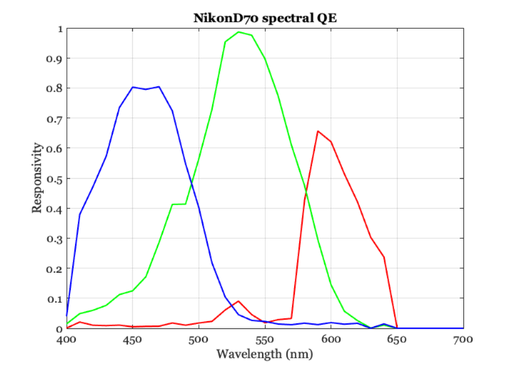
Estimated sensor correction transforms for the different illuminants
reflectances = ieReflectanceSamples(sFiles,sSamples); T = cell(1,nIlluminant); actual = cell(1,nIlluminant); desired = cell(1,nIlluminant); CMF = ieReadSpectra('XYZ.mat',wave); % imageSensorConversion returns the transform, T, that converts the sensor % data to the desired CMF representation. for ii = 1:nIlluminant illuminant = blackbody(wave,bbodyList(ii)); [T{ii}, actual{ii}, desired{ii}, whiteCMF] = ... imageSensorConversion(nikon,CMF,reflectances,illuminant); end % In this case, the T{ii} matrices convert the Nikon spectral QE to % something close to the XYZ. estXYZ = (T{3}*sqe')'; % Let's plot the transformed spectral QE for the 5000K illuminant ieNewGraphWin; p = plot(wave,estXYZ(:,1),'r:',wave,estXYZ(:,2),'g:',wave,estXYZ(:,3),'b:',... wave,CMF(:,1),'r-',wave,CMF(:,2),'g-',wave,CMF(:,3),'b'); set(p,'linewidth',2); xlabel('Wavelength (nm)'); ylabel('Responsivity'); hold off; grid on
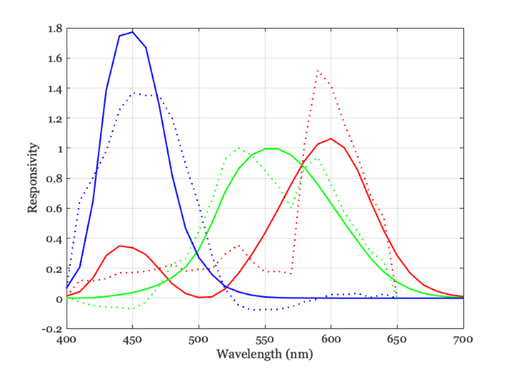
Not correctly implemented
scene = sceneCreate; oi = oiCreate; oi = oiCompute(oi,scene); nikon = sensorSet(nikon,'fov',sceneGet(scene,'fov'),oi); nikon = sensorCompute(nikon,oi); sensorWindow(nikon);
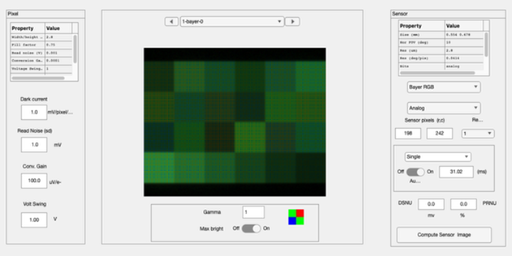
Plot the corrected and desired for each illuminant case
% Store the CIELAB delta E here dE = cell(1,nIlluminant); % T(3x3)*sensorData(3xN) is supposed to be XYZ for ii=1:nIlluminant corrected = T{ii}*actual{ii}; dE{ii} = deltaEab(corrected',desired{ii}',whiteCMF); end allDE = []; for ii=1:nIlluminant allDE = [allDE, dE{ii}]; %#ok<AGROW> end ieNewGraphWin; histogram(allDE,50); set(gca,'xlim',[0 maxDE]) xlabel('CIELAB \Delta E'); ylabel('Count') title(sprintf('Illuminant-dependent sensor correction (%s)',filterFile)); % close all

Use the average of the linear transformations
tmp = zeros(size(T{1}));
for ii=1:nIlluminant, tmp = tmp + T{ii}; end
Tave = tmp/nIlluminant;
for ii=1:nIlluminant
corrected = Tave*actual{ii};
dE{ii} = deltaEab(corrected',desired{ii}',whiteCMF);
end
allDE = [];
for ii=1:nIlluminant
allDE = [allDE, dE{ii}]; %#ok<AGROW>
end
ieNewGraphWin; histogram(allDE,50); set(gca,'xlim',[0 maxDE]) xlabel('CIELAB \Delta E') ylabel('Count') title(sprintf('Illuminant-independent sensor correction (%s)',filterFile)); fprintf('%s',filterFile) Tave %#ok<NOPTS> s = svd(Tave); fprintf('Condition number: %f\n',s(1)/s(3));
NikonD70
Tave =
2.2475 0.1414 0.1793
1.0149 0.9329 -0.2429
0.0176 -0.1268 1.7180
Condition number: 3.455386
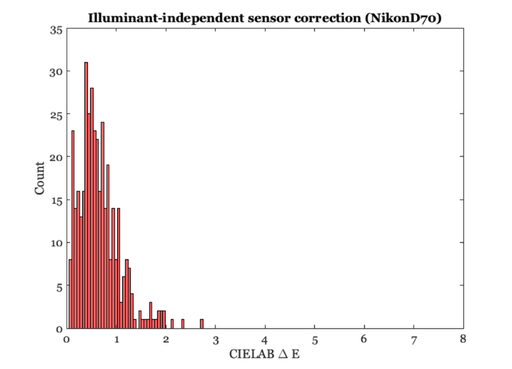
Create a sensor with different filters. (CYM)
% Set the sensor of interest here sensor = sensorCreate; wave = sensorGet(sensor,'wave'); % Load up CYM color filters sensor = sensorSet(sensor,'infrared',ieReadSpectra('infrared2',wave)); filterFile = 'cym'; sensor = sensorSet(sensor,'color filters',ieReadSpectra(filterFile,wave)); sensor = sensorSet(sensor,'name','CMY'); sqe = sensorGet(sensor,'spectral qe'); ieNewGraphWin; p = plot(wave,sqe(:,1),'c-',wave,sqe(:,2),'y-',wave,sqe(:,3),'m-'); set(p,'linewidth',2); grid on xlabel('Wavelength (nm)'); ylabel('Responsivity') title(sprintf('%s spectral QE',filterFile));
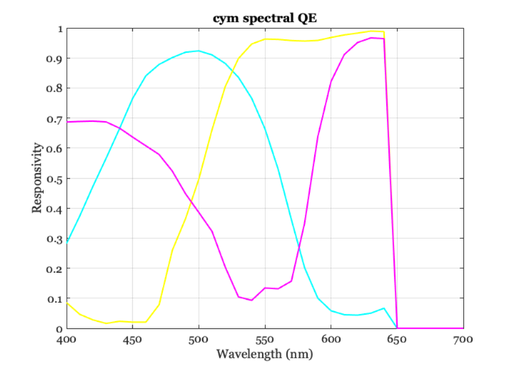
scene = sceneCreate; oi = oiCreate; oi = oiCompute(oi,scene); sensor = sensorSet(sensor,'fov',sceneGet(scene,'fov'),oi); sensor = sensorCompute(sensor,oi); sensorWindow(sensor); ip = ipCreate; ip = ipCompute(ip,sensor); ipWindow(ip);
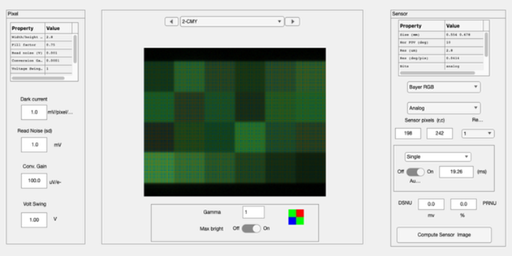
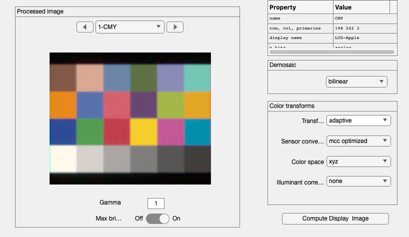
Estimated sensor correction transforms for the different illuminants
reflectances = ieReflectanceSamples(sFiles,sSamples); T = cell(1,nIlluminant); actual = cell(1,nIlluminant); desired = cell(1,nIlluminant); CMF = ieReadSpectra('XYZ.mat',wave); for ii = 1:nIlluminant illuminant = blackbody(wave,bbodyList(ii)); [T{ii}, actual{ii}, desired{ii}, whiteCMF] = ... imageSensorConversion(sensor,CMF,reflectances,illuminant); end % The T{ii} matrices convert the Nikon spectral QE to something close to % the XYZ. estXYZ = (T{3}*sqe')'; % Let's plot these for the 5000K illuminant ieNewGraphWin; p = plot(wave,estXYZ(:,1),'r:',wave,estXYZ(:,2),'g:',wave,estXYZ(:,3),'b:',... wave,CMF(:,1),'r-',wave,CMF(:,2),'g-',wave,CMF(:,3),'b'); set(p,'linewidth',2) xlabel('Wavelength (nm)'); ylabel('Responsivity'); l = legend(p([1,4]),{'T*CMY','XYZ'}); set(l,'Box','off','Color','none') hold off
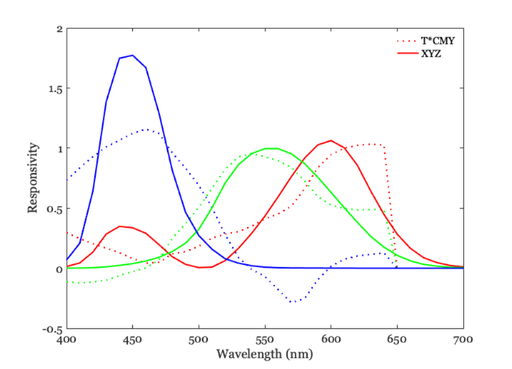
Plot the corrected and desired for each illuminant case
% These are really pretty good for the Nikon spectral QE dE = cell(1,nIlluminant); for ii=1:nIlluminant corrected = T{ii}*actual{ii}; dE{ii} = deltaEab(corrected',desired{ii}',whiteCMF); end allDE = []; for ii=1:nIlluminant allDE = [allDE, dE{ii}]; %#ok<AGROW> end % Error in CIELAB space ieNewGraphWin; histogram(allDE,50); set(gca,'xlim',[0 maxDE]) xlabel('CIELAB \Delta E'); ylabel('Count') title(sprintf('Illuminant-dependent sensor correction (%s)',filterFile));
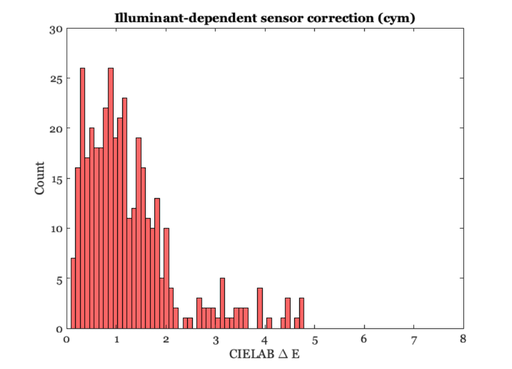
Use the average of the linear transformations to compute delta E
tmp = zeros(size(T{1}));
for ii=1:nIlluminant, tmp = tmp + T{ii}; end
Tave = tmp/nIlluminant;
for ii=1:nIlluminant
corrected = Tave*actual{ii};
dE{ii} = deltaEab(corrected',desired{ii}',whiteCMF);
end
allDE = [];
for ii=1:nIlluminant
allDE = [allDE, dE{ii}]; %#ok<AGROW>
end
ieNewGraphWin;
histogram(allDE,50);
set(gca,'xlim',[0 maxDE])
xlabel('CIELAB \Delta E')
ylabel('Count')
title(sprintf('Illuminant-independent sensor correction (%s)',filterFile));
% Tell the user about the condition number
fprintf('%s',filterFile)
Tave %#ok<NOPTS>
s = svd(Tave);
fprintf('Condition number: %f\n',s(1)/s(3));
cym
Tave =
-0.3225 0.5846 0.4856
0.2450 0.8471 -0.3738
0.7889 -0.7251 0.8168
Condition number: 2.195921
